#BatteryTechnology
Text


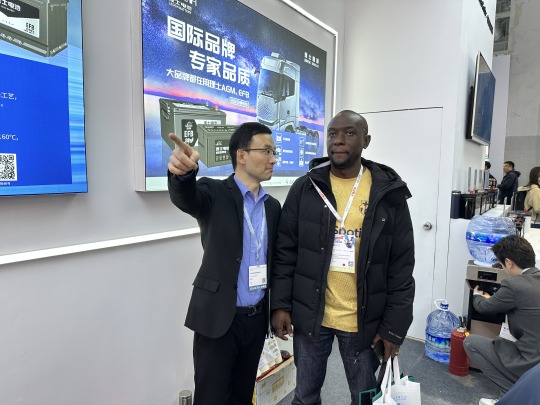
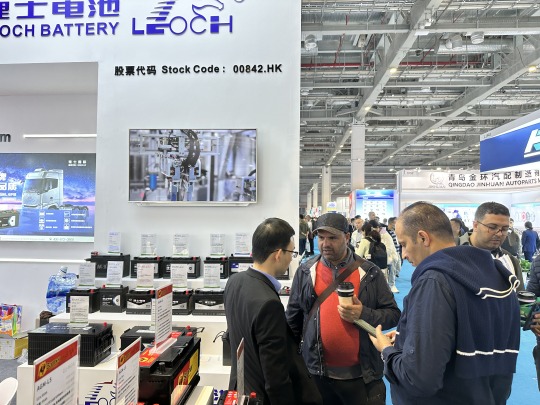
Leoch is the OE supplier for many international automobile manufacturing companies with years of automotive battery experience.
We are confident to be your reliable automotive battery partner! 🤝
Automechanika Shanghai 2023, Leoch is right here! 🚗🔋
#Automobile#CarBattery#Automechanika#EV#StartingBattery#MotiveBattery#AutomechanikaShanghai2023#LeochAutomotiveBatteries#OESupplier#AutomotiveBatteryExperience#ReliablePartner#AutomotiveIndustry#BatteryTechnology#AutomotivePower#BatterySupplier#AutomotiveExcellence
4 notes
·
View notes
Text
3D Printed Batteries Market is Dazzling Worldwide and Forecast to 2030 | GQ Research
The 3D Printed Batteries market is set to witness remarkable growth, as indicated by recent market analysis conducted by GQ Research. In 2023, the global 3D Printed Batteries market showcased a significant presence, boasting a valuation of USD 120.50 Million. This underscores the substantial demand for 3D Printed Batteries technology and its widespread adoption across various industries.
Get Sample of this Report at: https://gqresearch.com/request-sample/global-3d-printed-batteries-market/
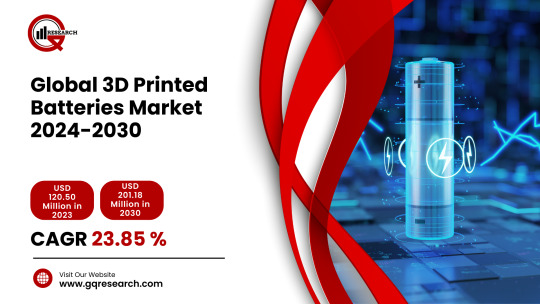
Projected Growth: Projections suggest that the 3D Printed Batteries market will continue its upward trajectory, with a projected value of USD 201.18 Million by 2030. This growth is expected to be driven by technological advancements, increasing consumer demand, and expanding application areas.
Compound Annual Growth Rate (CAGR): The forecast period anticipates a Compound Annual Growth Rate (CAGR) of 23.85 %, reflecting a steady and robust growth rate for the 3D Printed Batteries market over the coming years.
Technology Adoption:
The adoption of 3D printed batteries represents a significant leap forward in energy storage technology, offering unparalleled flexibility, customization, and efficiency. With the ability to fabricate intricate battery designs layer by layer, 3D printing revolutionizes the production process, enabling the creation of batteries with complex geometries and tailored properties. This technology finds applications across various industries, including electronics, automotive, aerospace, and renewable energy, where the demand for compact, lightweight, and high-performance energy storage solutions is paramount.
Application Diversity:
The application diversity of 3D printed batteries spans a wide range of industries and use cases, driven by the unique capabilities of additive manufacturing technology. In the electronics sector, 3D printed batteries power portable devices, wearable gadgets, and IoT sensors, providing compact and lightweight energy sources for mobile applications. In the automotive industry, these batteries support electric vehicles (EVs) and hybrid vehicles, offering improved energy density, faster charging times, and enhanced safety features. Additionally, 3D printed batteries find applications in aerospace, where lightweight and high-performance energy storage solutions are critical for space exploration and satellite missions, as well as in renewable energy systems, grid storage, and medical devices, among others.
Consumer Preferences:
Consumer preferences in the 3D printed batteries market are shaped by factors such as energy density, power output, reliability, and cost-effectiveness. End-users seek batteries that offer long-lasting performance, rapid charging capabilities, and compatibility with a wide range of devices and applications. Customization options, such as the ability to tailor battery designs to specific requirements and form factors, are also valued, allowing consumers to optimize energy storage solutions for their individual needs. Moreover, considerations related to sustainability and environmental impact play an increasingly important role in consumer decision-making, driving demand for eco-friendly battery materials and manufacturing processes.
Technological Advancements:
Technological advancements drive innovation and differentiation within the 3D printed batteries market, enabling manufacturers to develop batteries with improved performance, efficiency, and reliability. Ongoing research and development efforts focus on optimizing battery chemistries, electrode designs, and printing techniques to enhance energy density, cycle life, and safety features. Advanced materials, such as solid-state electrolytes and nanostructured electrodes, enable the fabrication of batteries with higher energy densities and faster charge/discharge rates. Furthermore, advancements in 3D printing technology, including multi-material printing, high-resolution printing, and process automation, enable the production of complex battery architectures with precise control over material composition and microstructure.
Market Competition:
The 3D printed batteries market is characterized by intense competition among established players and emerging startups, driving continuous innovation and market expansion. Established battery manufacturers, as well as companies specializing in additive manufacturing and materials science, vie for market share through the development of proprietary technologies, strategic partnerships, and product differentiation strategies. Additionally, the market landscape is influenced by factors such as intellectual property rights, regulatory compliance, and global supply chain dynamics, which impact the competitive positioning of companies across different regions and industry sectors.
Environmental Considerations:
Environmental considerations are increasingly shaping the 3D printed batteries market, with a growing emphasis on sustainability, circular economy principles, and resource efficiency. Manufacturers strive to minimize the environmental footprint of battery production processes by adopting eco-friendly materials, reducing waste generation, and optimizing energy consumption. Additionally, efforts are underway to develop recycling and end-of-life management strategies for 3D printed batteries, ensuring that valuable materials are recovered and reused in future manufacturing cycles. By embracing environmental responsibility, stakeholders in the 3D printed batteries market contribute to a more sustainable and resilient energy storage ecosystem, meeting the evolving needs of consumers and regulatory requirements..
Regional Dynamics: Different regions may exhibit varying growth rates and adoption patterns influenced by factors such as consumer preferences, technological infrastructure and regulatory frameworks.
Key players in the industry include:
Sakuu Corporation
Neware Technology LLC
Stratasys Ltd
Materialize NV
3D Systems
EOS GmbH
GE Additive
EXOne
Voxeljet
Envision Tec
The research report provides a comprehensive analysis of the 3D Printed Batteries market, offering insights into current trends, market dynamics and future prospects. It explores key factors driving growth, challenges faced by the industry, and potential opportunities for market players.
For more information and to access a complimentary sample report, visit Link to Sample Report: https://gqresearch.com/request-sample/global-3d-printed-batteries-market/
About GQ Research:
GQ Research is a company that is creating cutting edge, futuristic and informative reports in many different areas. Some of the most common areas where we generate reports are industry reports, country reports, company reports and everything in between.
Contact:
Jessica Joyal
+1 (614) 602 2897 | +919284395731 Website - https://gqresearch.com/
0 notes
Text
Lithium: Deciphering Market Trends, Emerging Technologies, and the Impact on Global Energy Transition
The global lithium market size is expected to reach USD 18.99 billion by 2030, according to a new report by Grand View Research, Inc. The market is expected to grow at a CAGR of 12.8% from 2024 to 2030. Rising investments in lithium mining and related technologies are projected to remain a key trend in the market. Lithium mining is witnessing rapid growth as its demand is accelerating owing to its application in batteries. The element is found in dry places that require thousands of liters of water for its mining. Considering the rising demand for elements and increasing usage of water required for its extraction, R&D is in place to find better alternative methods. For instance, in February 2020, funding of around USD 20 million by Bill Gates was provided to Lilac Solutions, a lithium mining technology firm located in the U.S.

Lithium Market Report Highlights
In terms of revenue, the hydroxide product segment is projected to register the fastest CAGR from 2024 to 2030. The rapid development of battery technologies is projected to remain a key driver for the segment
Automotive was the largest application segment in 2023. The rising penetration of Electric Vehicles (EVs) along with stringent emission regulations by government bodies is the key focus area for market vendors
The consumer electronics segment is projected to witness the highest CAGR over the forecast period, in terms of revenue, due to the high demand for electronic products, such as smartphones, tablets, laptops, wearables, portable speakers, and tablets
Asia Pacific was the largest regional market in 2023, in terms of both volume and revenue. The growth of the region can be attributed to the heavy investments in lithium mining as well as lithium-ion battery technologies
In terms of volume, Europe accounted for the second-largest market share in 2023. The growth of the region is attributable to the rising penetration of EVs and growing concerns about Greenhouse Gas (GHG) emissions
For More Details or Sample Copy please visit link @: Lithium Market Report
According to the firm, its ion exchange technology is two times more efficient compared to the current mining process and requires a fraction of time. Lithium recycling is a complex process; however, with the rising penetration of Li-ion batteries, the demand may outpace supply. Therefore, researchers are focusing on extraction and recycling through various new technologies. Lithium compounds are extracted from batteries as per individual methods and stages. The stages are divided into pre-treatment and extraction stages; while extraction is again categorized into hydrometallurgy, pyrometallurgy, and electrochemical extraction. Despite the growing emphasis and development of different recycling technologies, less than 1% of lithium is recycled currently.
Over the last decade, the rise in usage of Li-ion battery storage has led to a decline in their prices by over 80%, leading to enhanced energy storage and paving the way for Electric Vehicles (EVs) to be commercially viable. Government regulations and subsidies are working on expanding clean energy; thus, energy storage systems represent a huge opportunity for investors. However, expensive raw materials required to produce energy storage systems may remain a critical factor for investors. As per the International Energy Agency, new companies in clean energy have attracted significant investments during the COVID-19 pandemic. Early-stage Venture Capital (VC) investments reduced slightly in the first half of 2020. However, these investments recovered quickly, with record investments from the third quarter of 2020.
#LithiumMarket#RenewableEnergy#BatteryTechnology#ElectricVehicles#EnergyStorage#Sustainability#ResourceInvesting#Mining#SupplyChain#MarketAnalysis
0 notes
Text
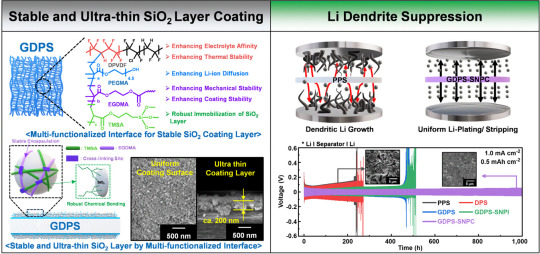
The separator between the anode and cathode of a lithium-ion battery poses a major engineering challenge. Separator failure leads to an internal short circuit, with potentially catastrophic results. But simply increasing the separator thickness reduces battery capacity and can impede the flow of ions that the battery needs to function. A group of Korean researchers thinks they've made progress, with a thin SiO2 coating for a polymer separator.
0 notes
Text
Powering the Future: The Train Battery Market
The global push towards sustainable transportation is driving significant growth in the train battery market. As countries around the world seek to reduce carbon emissions and combat climate change, electrification initiatives in the transportation sector are gaining momentum. Train batteries play a crucial role in powering electric trains, providing energy storage for propulsion and onboard systems.
One of the key drivers of the train battery market is the rapid urbanization and the increasing demand for efficient mass transit solutions. With cities becoming more crowded and congested, governments are investing in electrified rail networks to alleviate traffic congestion and reduce pollution. Electric trains powered by advanced batteries offer a clean and efficient mode of transportation, meeting the growing demand for sustainable mobility solutions.
Moreover, technological advancements in battery technology are driving innovation in the train battery market. Lithium-ion batteries, known for their high energy density and long cycle life, are increasingly being adopted for train electrification projects. These batteries offer improved performance and reliability, enabling electric trains to travel longer distances on a single charge.
In addition to passenger trains, train batteries are also gaining traction in the freight transportation sector. Electric freight trains powered by batteries offer lower operating costs and reduced environmental impact compared to diesel-powered locomotives. As a result, railway operators are increasingly investing in electrified freight corridors, driving the demand for train batteries.
Furthermore, government initiatives and policies promoting electrification are providing a significant impetus to the train battery market. Subsidies, tax incentives, and regulatory mandates are encouraging railway operators to transition to electric trains powered by batteries. Incentive programs aimed at reducing greenhouse gas emissions are further accelerating the adoption of electric trains, creating lucrative opportunities for manufacturers in the train battery market.
Looking ahead, the outlook for the train battery market is optimistic. As the global transportation industry continues to embrace electrification, the demand for advanced train batteries will continue to grow. Key market players are investing in research and development to develop more efficient and cost-effective battery solutions, driving innovation and propelling the growth of the train battery market.
#TrainBattery#RailwayElectrification#Transportation#Sustainability#EnergyStorage#ElectricTrains#RenewableEnergy#BatteryTechnology#Urbanization#MarketGrowth
0 notes
Text
Energy storage materials are substances or systems capable of storing energy for later use. These materials play a crucial role in various applications, including renewable energy storage, portable electronics, electric vehicles, and grid stabilization. Several types of energy storage materials exist, each with unique properties and applications. Here are some common categories:
Visit : https://electronicmaterialsconference.com/
#EnergyStorage#BatteryTechnology#RenewableEnergyStorage#LithiumIon#Supercapacitors#HydrogenStorage#ThermalEnergyStorage#FlywheelTechnology#MaterialsScience#GridStorage#ElectrochemicalMaterials#EnergyInnovation#SustainableEnergy#GreenTech#SmartGrid#EnergyEfficiency#PowerStorage#AdvancedMaterials#CleanEnergy#EnergyTransition
0 notes
Text
0 notes
Text
Powering the Future: How Radical Electrification Can Fight Climate Change and Create Jobs
#batterytechnology #cleanenergy #climatechange #economicchallenges #electricvehiclechargingnetworks #electricvehicles #governmentpolicies #greenhousegasemissions #gridstability #infrastructureinvestment #privatesectorinvestments #Radicalelectrification #renewableenergysources
#Business#batterytechnology#cleanenergy#climatechange#economicchallenges#electricvehiclechargingnetworks#electricvehicles#governmentpolicies#greenhousegasemissions#gridstability#infrastructureinvestment#privatesectorinvestments#Radicalelectrification#renewableenergysources
0 notes
Text
Electric Vehicle Battery Market Solid Analyzed Segmentation, Demand, and Share Estimation by 2030

The qualitative report published by Exactitude Consultancy research on the “Electric Vehicle Battery Market offers an in-depth examination of the current trends, latest expansions, conditions, market size, various drivers, limitations, and key players along with their profile details. The Electric Vehicle Battery market report offers the historical data for 2018 to 2023 and also makes available the forecast data from the year 2024 to 2030 which is based on revenue. With the help of all this information research report helps the Market contributors to expand their market positions. With the benefit of all these explanations, this market research report recommends a business strategy for present market participants to strengthen their role in the market. This report analyzes the impact of the Covid 19 pandemic on the Electric Vehicle Battery Market from a Global and Regional perspective.
The global electric vehicle battery market is expected to grow at 21% CAGR from 2024 to 2030. It is expected to reach above USD 95 billion by 2030 from USD 17 billion in 2023.
For The Full Report Click here:
https://exactitudeconsultancy.com/reports/1879/electric-vehicle-battery-market/
#ElectricVehicleBattery#EVBattery#BatteryTechnology#BatteryMarket#ElectricVehicle#EVMarket#LithiumIonBattery#BatteryInnovation#BatterySupplyChain#BatteryManufacturing#EVIndustry#CleanEnergy#RenewableEnergy#SustainableMobility#FutureOfMobility#GreenTechnology#ElectricCars#EVCharging#BatteryManagementSystem
0 notes
Text
💥 Discover the amazing process of welding positive and negative wires of a lithium battery pack 🔋✨ These remarkable sparks of innovation create the backbone of our modern technology. Join us as we delve into the fascinating world of battery manufacturing, uncovering the crucial steps that power our devices. Get ready for an electrifying journey! ⚡️
#lithiumbattery#lithiumbatterypack#lithiumbatteryfactory#lifepo4lithiumbattery#daxingpower#newenergy#batterymanufacturer#BatteryTechnology#powersupply#EnergyStorage#GreenEnergySolutions#EnergyStorageProducts
0 notes
Text
Green Technology: A Game-Changer in the Fight Against Climate Change

The Impact of Green Technology on Climate Change: A Closer Look
In a world grappling with the escalating consequences of climate change, green technology has emerged as a beacon of hope. It represents a transformative approach to addressing environmental challenges by harnessing sustainable practices, renewable energy sources, and innovative eco-friendly tech solutions. In this article, we will delve into the realm of green technology, exploring its diverse facets, its impact on climate change mitigation, and its potential to usher in a more sustainable future for our planet.
1. Understanding Green Technology
Green technology, often referred to as clean technology or eco-friendly technology, encompasses a wide array of innovations and practices designed to minimize the environmental impact of human activities. Its primary aim is to reduce resource consumption, minimize waste generation, and lower greenhouse gas emissions. Let's take a closer look at some key components of green technology:
1.1 Renewable Energy Sources
One of the cornerstones of green technology is the utilization of renewable energy sources, such as solar, wind, and hydroelectric power. These sources generate electricity without depleting finite resources or emitting harmful pollutants. Solar panels, wind turbines, and hydroelectric dams have become increasingly prevalent as the world seeks cleaner alternatives to fossil fuels.
1.2 Energy Efficiency
Improving energy efficiency is another crucial aspect of green technology. This involves developing technologies and practices that consume less energy to achieve the same or even enhanced results. From LED lighting and smart thermostats to energy-efficient appliances and well-insulated buildings, energy efficiency plays a pivotal role in reducing carbon footprints.
1.3 Sustainable Transportation
Green technology extends its reach to transportation solutions. Electric vehicles (EVs) have gained traction as a sustainable alternative to traditional gasoline-powered cars. Furthermore, advancements in public transportation systems, including electric buses and high-speed trains, contribute to reduced emissions and traffic congestion.
1.4 Waste Reduction and Recycling
Efforts to minimize waste and promote recycling are fundamental to green technology. Innovations in waste management, such as waste-to-energy conversion and biodegradable materials, are helping to divert waste from landfills and reduce environmental harm.

Green Technology Impact
2. The Role of Green Technology in Combating Climate Change
Now that we've established what green technology encompasses, let's explore its significant role in mitigating climate change:
2.1 Reduced Carbon Emissions
The transition from fossil fuels to renewable energy sources is pivotal in reducing carbon emissions. Solar and wind power, in particular, produce electricity without emitting carbon dioxide, making them key players in the fight against climate change. As more countries adopt these technologies, the global carbon footprint is expected to decrease significantly.
2.2 Energy Independence
Green technology promotes energy independence by reducing reliance on fossil fuel imports. Countries that invest in renewable energy sources become less vulnerable to energy supply disruptions and price fluctuations in the global market, enhancing their economic stability.
2.3 Sustainable Agriculture
Innovations in agriculture, a critical component of green technology, enable farmers to adopt sustainable practices. These practices reduce deforestation, limit the use of harmful pesticides and fertilizers, and promote soil health. Sustainable agriculture not only combats climate change but also ensures food security for future generations.
2.4 Conservation of Natural Resources
Green technology also focuses on conserving natural resources, such as clean water and forests. Technologies like water purification systems and sustainable forestry practices help protect vital ecosystems and biodiversity, which are essential for climate regulation.

The Impact of Green Technology
3. Innovations in Green Technology
To combat climate change effectively, green technology continually evolves and innovates. Here are some recent breakthroughs in the field:
3.1 Battery Technology
Advancements in battery technology have accelerated the adoption of renewable energy sources. Energy storage solutions, such as lithium-ion batteries and emerging solid-state batteries, are making it possible to store excess energy generated by solar and wind installations for use during cloudy or windless periods.
3.2 Carbon Capture and Utilization (CCU)
CCU technologies capture carbon dioxide emissions from industrial processes and convert them into valuable products or store them underground. This innovation helps industries reduce their carbon footprint while turning a liability into an asset.
3.3 Artificial Intelligence (AI)
AI-driven algorithms optimize energy consumption in buildings, factories, and transportation systems. By analyzing data and making real-time adjustments, AI enhances energy efficiency and reduces waste.
3.4 Circular Economy
The concept of a circular economy encourages reusing, recycling, and refurbishing products instead of producing and disposing of them. This approach minimizes waste and extends the lifespan of goods, reducing the strain on natural resources.
4. The Global Impact of Green Technology
Green technology is not limited to developed countries; it has a global impact. Developing nations are increasingly embracing eco-friendly tech solutions as they seek to balance economic growth with environmental sustainability. International collaborations and agreements, such as the Paris Agreement, encourage countries to commit to reducing emissions and investing in green technology.
5. Challenges and Future Prospects of Green Technology
While green technology holds immense promise, it faces certain challenges, including the initial high costs of implementation and the need for infrastructure upgrades. Nevertheless, as technology continues to advance, costs are likely to decrease, making green solutions more accessible.
Overview of Green Technology
Green technology represents humanity's collective effort to address climate change and build a sustainable future. By harnessing renewable energy sources, improving energy efficiency, and embracing sustainable practices, we can significantly reduce our carbon footprint. The innovations in green technology we've discussed are not only combating climate change but also creating opportunities for economic growth and a healthier planet. As individuals, communities, and nations, we must continue to support and invest in green technology to ensure a brighter, more sustainable future for generations to come.
Read This Also 👉 Fiverr Affiliate Program. How to earn $1000 per month with Fiverr Affiliate?
Watch Video 📺 👉 How to Earn Money Online? Create a Fiverr Buyer and Seller Account | Abhishek InfoTech

Read the full article
#10GreenTechInnovationsThatAreMakingaDifference#ArtificialIntelligence(AI)#BatteryTechnology#CarbonCaptureandUtilization(CCU)#ChallengesandFutureProspectsofGreenTechnology#CircularEconomy#ConservationofNaturalResources#Eco-FriendlyTechInnovationsThatAreChangingtheWorld#Eco-FriendlyTechSolutionsThatAreWorthInvestingIn#Eco-FriendlyTechSolutions:AComprehensiveGuide#Eco-FriendlyTechSolutions:ACrucialRoleinCombatingClimateChange#EnergyEfficiency#EnergyIndependence#GreenTechforDummies:ASimpleGuidetoEco-FriendlyTechnology#GreenTechSolutionstoCombatClimateChange:AComprehensiveGuide#GreenTechTrendstoWatchin2023andBeyond#GreenTech:ASolutionforOurClimateCrisis#GreenTechnology#GreenTechnologytotheRescue:HowEco-FriendlyTechSolutionsCanCombatClimateChange#GreenTechnology:AGame-ChangerintheFightAgainstClimateChange#GreenTechnology:AMust-ReadGuideforAnyoneConcernedAboutClimateChange#GreenTechnology:APowerfulToolforaSustainableFuture#GreenTechnology:ASolutiontoClimateChangeThat'sHereToday#GreenTechnology:TheFutureofaSustainablePlanet#GreenTechnology:TheFutureofCombatingClimateChange#HowGreenTechIsChangingtheWorldandCombatingClimateChange#HowGreenTechIsMakingOurLivesBetterandReducingOurCarbonFootprint#HowGreenTechnologyCanHelpUsFightClimateChange:AComprehensiveGuide#HowGreenTechnologyCanHelpUsSavethePlanet#HowtoInvestinGreenTechandMakeaDifference
0 notes
Text
Starting batteries are not only necessary to start the engine, but also to power the electrical components during driving. 🔋
Discover the benefits of Leoch starting batteries:
① Excellent resistance to high and low temperatures
② Withstand frequent starting
③ Resistant to shock and vibration
④ Safe and environmentally friendly
Watch the video and then start your car with Leoch Battery!💨
Starting your journey with Leoch's powerful starting batteries. 🚗
#StartingBattery#HighEfficiency#ExcellentPerformance#EV#BatteryTechnology#LeochStartingBatteries#PowerfulStart#EngineStarting#ElectricalPower#HighLowTemperatureResistance#FrequentStarting#ShockVibrationResistance#SafeEnvironmentallyFriendly#CarBattery#LeochBattery
3 notes
·
View notes
Text
Northvolt Secures Record $5 Billion in Debt Financing for Expansion and Recycling Facility

Europe’s Leading Battery Manufacturer Readies For Possible Stock Market Listing
In a significant development, Northvolt, the Swedish battery manufacturer, has solidified its status as Europe’s best-funded start-up by securing a groundbreaking $5 billion in debt financing. The funding, acknowledged as the largest green loan in Europe to date, is poised to fuel the expansion of the company’s inaugural gigafactory and the construction of a state-of-the-art recycling facility on the same site. This move highlights the insatiable demand for capital in the region’s burgeoning battery sector and positions Northvolt for potential stock market listing, pending improved market conditions.
Record-Breaking Financing
Northvolt’s recent announcement validates earlier reports from the Financial Times in March, indicating the company’s intent to raise $5 billion in debt. The funds were sourced from a consortium of 23 banks, alongside significant contributions from the European Investment Bank and the Nordic Investment Bank. This financing, which encompasses the refinancing of a $1.6 billion debt package from July 2020, brings the company’s total raised capital to over $13 billion, facilitating its ambitious plan to establish four major factories across Sweden, Germany, and Canada by the decade’s end.
Challenges and Milestones at Northvolt Ett
The financing will play a pivotal role in realizing the full potential of Northvolt Ett, the company’s inaugural gigafactory situated below the Arctic Circle in northern Sweden. Although the company Ett commenced battery production in late 2021, it faced delays and setbacks, impacting overall production. Notably, the Swedish truckmaker Scania, among other customers, has been awaiting deliveries from Northvolt Ett, contributing to the company’s losses, which surged eight-fold to nearly SKr11 billion ($1.1 billion) for the first three quarters of 2023 compared to the previous year.
Focus on Sustainability and Circular Practices
Peter Carlsson, Northvolt’s CEO and co-founder, emphasized the financing as a milestone for the European energy transition. The funds will not only support the gigafactory but also finance the adjacent recycling plant, Revolt Ett. This marks the first instance of a company outside Asia placing a recycling facility next to battery manufacturing. According to Northvolt, recycled battery materials boast a 70% lower carbon footprint than mined minerals, reinforcing the company’s commitment to sustainable and circular business practices.
Environmental Recognition and Future Challenges
Northvolt received a commendable “dark green” rating from Cicero, a Norwegian consultancy assessing the environmental quality of debt offerings. Emma Nehrenheim, Chief Environmental Officer at Northvolt, expressed pride in attracting top-tier financial partners, noting that global capital is increasingly keen on investing in electrification and climate change mitigation. Despite the challenges faced by the company, executives remain optimistic, anticipating that future gigafactories will necessitate their own multibillion-dollar financing packages.
Northvolt received advisory support from BNP Paribas, Allen & Overy, and Mannheimer Swartling, underscoring the strategic collaboration behind this monumental financing endeavor. As Northvolt navigates its expansion and sustainability initiatives, the battery manufacturer is positioned as a trailblazer in Europe’s transition towards greener energy solutions.
Also Read: Pallet Jacks: The Backbone of Efficient Warehousing and Logistics
#Northvolt#GreenFinance#BatteryTechnology#Sustainability#EuropeanStartups#DebtFinancing#RecyclingFacility#Gigafactory
0 notes
Text
Cobalt Market: Understanding the Role in Renewable Energy, Electric Vehicles, and Technological Advancements
The global cobalt market is expected to reach USD 25.91 billion by 2030, according to a new report by Grand View Research, Inc., expanding at a CAGR of 6.2% over the forecast period. Increasing demand for electric vehicles (EVs) is expected to propel the demand for cobalt in battery applications over the forecast period. The demand for EVs has been increasing rapidly due to concerns about climate change, rising fuel prices, and government incentives. Cobalt is a key component in the production of lithium-ion batteries used in EVs. Based on products, the cobalt oxide segment is expected to register a CAGR of 6.1%, in terms of revenue, over the forecast period. It is used as a colorant in ceramic and glass production, where it imparts a blue color to the final product.

Cobalt Market Report Highlights
The EVs application segment held the largest revenue share of over 35.0% in 2022 due to factors, including environmental concerns, government policies, technological advancements, cost savings, and increasing consumer demand
The industrial chemicals segment is expected to register a CAGR of 5.6%, in terms of revenue, over the forecast period. Cobalt oxide is used as a catalyst in a variety of chemical reactions, including the production of chemicals, fuels, and polymers. The expansion in the chemical industry is expected to drive the segment growth
The cobalt sulfate product segment held the largest revenue share of over 70.0% in 2022, and this trend is expected to continue over the forecast period. The segment growth is attributed to the high product demand from various end-use industries, such as batteries, electroplating, pharmaceuticals, and agriculture
Asia Pacific is expected to register the fastest CAGR of 6.7%, in terms of revenue, over the forecast period. The increasing demand for EVs, renewable energy storage, consumer electronics, and infrastructure development in Asia Pacific is driving the product demand in the regional market
For More Details or Sample Copy please visit link @: Cobalt Market Report
The growing demand for ceramics and glass in various industries, such as construction and electronics, is driving the demand for cobalt oxide. The superalloy application segment is expected to register high growth over the forecast years. A cobalt-based superalloy is known for its high-temperature stability, which makes it suitable for use in high-temperature applications. Thus, its unique combination of physical and chemical properties makes it an ideal material for high-temperature and high-stress applications in the aerospace, energy, and other industries. Based on region, there lies immense opportunity for the market to flourish in Europe. The growth of renewable energy sources, such as wind and solar power, is driving the demand for energy storage systems, which is propelling the production of lithium batteries that use cobalt.
As Europe aims to transition toward a cleaner energy future, the demand for renewable energy storage systems is increasing, thereby driving market growth. For instance, a comprehensive energy law package passed by the German government in April 2022 aims to increase the amount of renewable energy generated in the country by 22,000 MW from solar and 10,000 MW from wind by 2030. The market participants continue to expand their production capacities to stay ahead of the competition. For instance, in February 2023, Eurasian Resources Group announced an investment of USD 1.8 billion for doubling its output of African copper and cobalt processed at a mine near Lubumbashi, the Democratic Republic of Congo. This indicates a high demand and growing competitive rivalry.
#CobaltMarket#RenewableEnergy#ElectricVehicles#BatteryTechnology#ResourceManagement#GreenTechnology#EconomicDevelopment#EnvironmentalImpact#TechnologicalAdvancements#InvestmentOpportunities#RegulatoryCompliance#CircularEconomy#MineralResources#EnergyStorage
0 notes
Text
Hard carbon for high capacity sodium batteries
As electronic devices, batteries are fairly simple. Charge is stored through the accumulation of ions at one electrode, and released to the circuit through the movement of ions to the other electrode. Because ions have mass and take up space, however, optimizing battery structures can involve complex materials engineering challenges.
As Daisuke Igarashi and colleagues at Tokyo University of Science explained in an article in Advanced Energy Materials, replacing lithium ion batteries with batteries based on sodium ions can potentially reduce costs and lay a more sustainable foundation for battery-driven devices. Sodium is not a drop-in replacement for lithium, though. It is heavier, reducing the available capacity per kilogram. Sodium batteries also operate at a lower voltage because the Na+/Na potential is higher than that of Li+/Li.
One way to increase battery capacity is to reduce the fraction of non-ionic components in the electrode. In lithium batteries, carbon facilitates the transport of charge from the lithium ions to the circuit. Reducing the volume of carbon by intercalating ions between thin graphite sheets can squeeze more charge-carrying particles into the same overall volume.
In sodium batteries, though, unstable sodium-graphite intercalation compounds can form. Instead of graphite, the Tokyo University group turned to porous hard carbon electrodes. Hard carbon is a low crystallinity carbon structure in which pores separate pseudo-graphitic domains. While the exact mechanism by which sodium ions insert themselves into these pores is still being studied, they seem to first adsorb on defect sites, then intercalate into the graphitic domains, and finally form small clusters in the internal pores. To enhance charge capacity, then, manufacturers seek to optimize the pore structure.
One possible solution relies on metallic gluconate to form a template structure. First, pyrolysis of Mg, Zn, or Ca gluconate embeds metal oxide particles in a carbon matrix. Acid leaches the metallic components away, leaving pores. Finally, heating in an inert atmosphere reduces any residual oxygen and volatilizes elemental metal, leaving porous hard carbon behind.
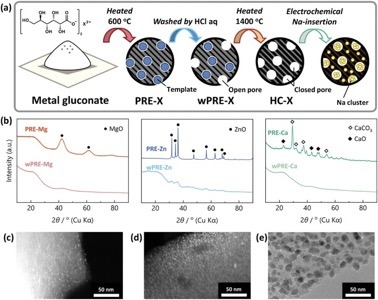
a) Illustration of template synthesis method. b) XRD patterns of PRE‐X and wPRE‐X, where X = Mg (left), Zn (middle), or Ca (right). Dark‐field TEM images of c) PRE‐Mg, and d) PRE‐Zn, in which MgO and ZnO are indicated as bright spots. e) Bright‐field TEM images of PRE‐Ca. Image source: https://onlinelibrary.wiley.com/doi/10.1002/aenm.202302647
Pyrolysis behavior is complex; differences in the pyrolysis behavior of Ca, Zn, and Mg gluconate lead to differences in the resulting pore size. Of the three, Zn Glu gave the best overall performance. With an energy density of 312 W-h/kg, sodium cells based on the ZnO template approached the lithium state of the art.
As the battery market grows, the relative scarcity of lithium is a strategic issue for rapidly electrifying economies and the companies that serve them. The emergence of competing batteries based on more abundant elements like sodium can help reinforce the trend to electrification.
0 notes